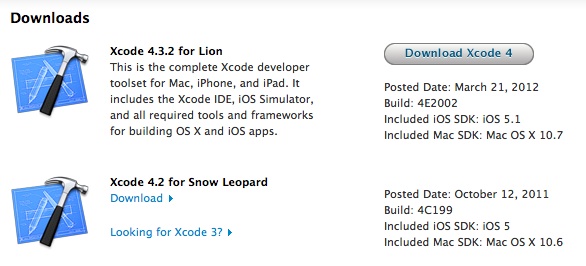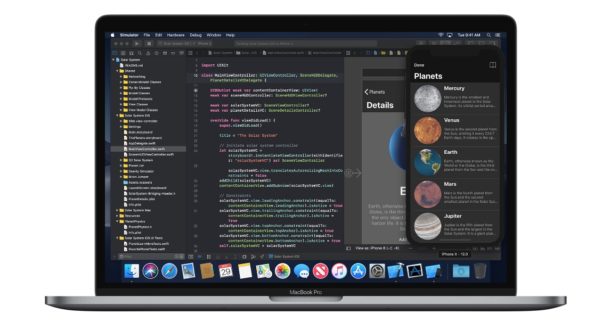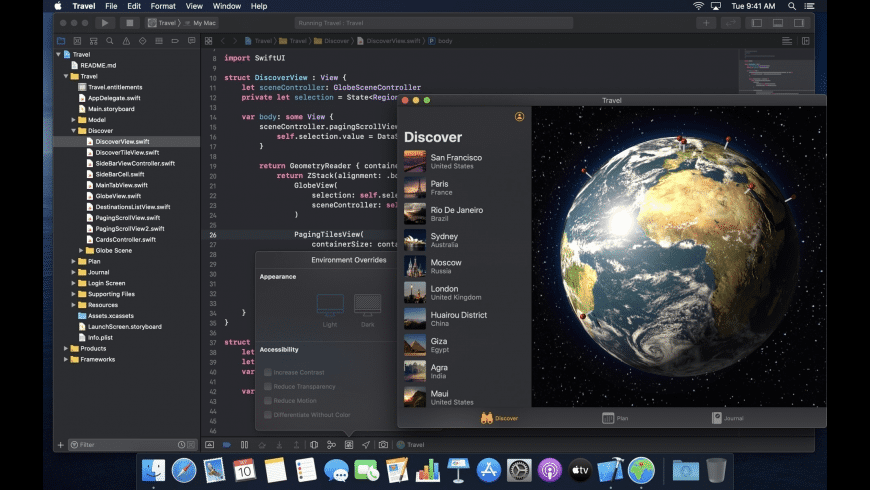With an all-new design that looks great on macOS Big Sur, Xcode 12 has customizable font sizes for the navigator, streamlined code completion, and new document tabs. Xcode 12 builds Universal apps by default to support Mac with Apple Silicon, often without changing a single line of code.
Apple disclaims any and all liability for the acts, omissions and conduct of any third parties in connection with or related to your use of the site. All postings and use of the content on this site are subject to the Apple Developer Forums Participation Agreement. What you need to do is to update your Mac OS to version 10.11.15 or later as the error message said. You can do it by opening App Store application from your mac and find the ‘Updates’ tab. Xcode can't be installed on 'Macintosh HD' because OS X version 10.12 or later is required. Version 10.12 isn't available to update to! How can I download Xcode?! Do you aware C-sharp?
Designed for macOS Big Sur.
Xcode 12 looks great on macOS Big Sur, with a navigator sidebar that goes to the top of the window and clear new toolbar buttons. The navigator defaults to a larger font that’s easier to read, while giving you multiple size choices. New document tabs make it easy to create a working set of files within your workspace.
Document tabs.
The new tab model lets you open a new tab with a double-click, or track the selected file as you click around the navigator. You can re-arrange the document tabs to create a working set of files for your current task, and configure how content is shown within each tab. The navigator tracks the open files within your tabs using strong selection.
Navigator font sizes.
The navigator now tracks the system setting for “Sidebar icon size” used in Finder and Mail. You can also choose a unique font size just for Xcode within Preferences, including the traditional dense information presentation, and up to large fonts and icon targets.
Code completion streamlined.
A new completion UI presents only the information you need, taking up less screen space as you type. And completions are presented much faster, so you can keep coding at maximum speed.
Redesigned organizer.
An all-new design groups all critical information about each of your apps together in one place. Choose any app from any of your teams, then quickly navigate to inspect crash logs, energy reports, and performance metrics, such as battery consumption and launch time of your apps when used by customers.
SwiftUI
SwiftUI offers new features, improved performance, and the power to do even more, all while maintaining a stable API that makes it easy to bring your existing SwiftUI code forward into Xcode 12. A brand new life cycle management API for apps built with SwiftUI lets you write your entire app in SwiftUI and share even more code across all Apple platforms. And a new widget platform built on SwiftUI lets you build widgets that work great on iPad, iPhone, and Mac. Your SwiftUI views can now be shared with other developers, and appear as first-class controls in the Xcode library. And your existing SwiftUI code continues to work, while providing faster performance, better diagnostics, and access to new controls.
Universal app ready.
Xcode 12 is built as a Universal app that runs 100% natively on Intel-based CPUs and Apple Silicon for great performance and a snappy interface.* It also includes a unified macOS SDK that includes all the frameworks, compilers, debuggers, and other tools you need to build apps that run natively on Apple Silicon and the Intel x86_64 CPU.
Updated automatically
When you open your project in Xcode 12, your app is automatically updated to produce release builds and archives as Universal apps. When you build your app, Xcode produces one binary “slice” for Apple Silicon and one for the Intel x86_64 CPU, then wraps them together as a single app bundle to share or submit to the Mac App Store. You can test this at any time by selecting “Any Mac” as the target in the toolbar.
Test multiple architectures.
On the new Mac with Apple Silicon, you can run and debug apps running on either the native architecture or on Intel virtualization by selecting “My Mac (Rosetta)” in the toolbar.
Multiplatform template
New multiplatform app templates set up new projects to easily share code among iOS, iPadOS, and macOS using SwiftUI and the new lifecycle APIs. The project structure encourages sharing code across all platforms, while creating special custom experiences for each platform where it makes sense for your app.
Improved auto-indentation
Swift code is auto-formatted as you type to make common Swift code patterns look much better, including special support for the “guard” command.
StoreKit testing
New tools in Xcode let you create StoreKit files that describe the various subscription and in-app purchase products your app can offer, and create test scenarios to make sure everything works great for your customers — all locally testable on your Mac.
Get started.
Download Xcode 12 and use these resources to build apps for all Apple platforms.
Would you like to develop software for Mac OS X or iOS? While it’s easy to develop apps for Linux and Windows on any platform, developing software for Mac requires a toolset called XCode, designed and built by Apple specifically for Mac OS X.
XCode is an incredibly powerful piece of software. Not only is it a complete toolset for developing Mac apps; it’s also an interface builder, testing application, and asset management toolkit.
In this simple guide, you’ll learn how to use XCode on Windows – something that’s normally impossible. All you’ll need is a Windows PC, a copy of Mac OS X, an Apple account, and an Internet connection.
Is this your first time using XCode? Learn how to program software for Mac and iOS with our 1 Hour XCode Introduction.
Installing a virtual PC application with Mac OS X
Since XCode only runs on Mac OS X, you’ll need to be able to simulate an installation of Mac OS X on Windows. This is surprisingly easy to do with virtualization software like VMWare or open source alternative VirtualBox.
Why Can't I Download Xcode On My Mac

For the purpose of this guide, we’ll be using VirtualBox. If you use a different virtual computer application, the process is much the same. Since VirtualBox is open source and free to use, it’s worth downloading it if you don’t already have a copy installed.
Have you never used VirtualBox before? Learn how to use this powerful virtual PC application by enrolling in our course, QuickStart! – Virtual Box. In addition to Mac OS X, VirtualBox can also be used to run Linux and other operating systems.
Running a virtual computer is quite a demanding process, and you’ll need to have a fairly powerful PC for it to operate successfully. You’ll also need a PC with hardware similar to that of a standard, Apple-constructed iMac, MacBook, or Mac Pro.
To successfully emulate a Mac using a Windows PC, you’ll need the following:
- A Dual Core Intel processor
- At least 2GB of RAM (4GB+ recommended)
- Hardware Virtualization
Is your PC too weak to emulate a Mac properly? Learn how to build a powerful PC for gaming, app development, and more with our Learn How to Build a Computer course.
You’ll also need an installation disc for Mac OS X. You can purchase this online from the Apple Store or, if you already own a MacBook, iMac, or Mac Pro, you can use the install disc you received with your computer.
Once you’ve installed VirtualBox, open the application and choose to install Mac OS X Server 64 Bit. Provide the virtual computer with at least 2GB of RAM (if you have more than 8GB of RAM, choose 4GB+) and more than 30GB of hard disk space.
VirtualBox will automatically configure the operating system, but you’ll still need to make a few changes manually. Open the Settings menu and carry out the following changes:

- On the System tab, uncheck Enable EFI
- On the Processor tab, select at least two CPUs
- On the Display tab, increase the video memory to at least 128MB
Installing Mac OS X and booting your virtual machine
Finally, you’ll need to download a Hackboot boot loader to install OS X. You can find a Hackboot install file by searching Google – in this case, you’ll need Hackboot 1 and Hackboot 2, as well as your OS X disc, to complete the installation.
Select your Hackboot 1 disc image, and then start the virtual machine. Your virtual machine will boot, and you’ll see an OS X screen. Using the menu at the bottom of the screen, launch the disc drive that contains your OS X installation disc.
From here, you’ll need to follow the installation instructions for Mac OS X. It takes several minutes to install the operating system. Once the process is finished, you’ll need to switch off your virtual machine and change your boot disc.
Reopen VirtualBox and, leaving all of your other settings the same, switch your boot disc from Hackboot 1 to Hackboot 2. You’ll boot into a screen with two icons. Select Mac OS X and press Enter to initiate the Mac OS X boot sequence.

Why Can't I Download Xcode On My Mac
During the Mac OS X configuration sequence, you’ll need to enter your Apple ID. This is necessary for downloading the XCode toolset later, so make sure you enter a valid Apple account when you configure your operating system.
Installing XCode on your Mac OS X virtual machine
Once you’ve configured your Mac OS X virtual machine, installing XCode is relatively easy. Before you install XCode, you’ll want to configure your virtual machine to your preferred resolution and settings using the System Preferences menu.
Is this your first time using Mac OS X? If you’re a PC user, finding your way around in the new interface can be a challenge. Enroll in Using Mac OS X for Windows Users to learn the basics of the OS X interface, from the Dock to features like Spotlight.
From here, installing XCode is simple. Open the App Store application from the dock and type XCode into the search bar. You might need to reenter your account details, or enter them for the first time if you didn’t do so during Mac OS X configuration.
Navigate to the XCode app and click Install Now to download it. If you don’t have an Apple account, you’ll need to create one in order to download the XCode toolset for your virtual machine.
XCode is quite a large application, and downloading it could take anywhere from a minute to several hours, depending on your Internet connection speed. Once your download is finished, open Applications and click XCode to launch the installer.
Once the installation process is complete, you’ll be able to use XCode within your virtual machine to program apps for Mac OS or iOS. You can also download other Mac apps to use on your virtual machine, although they may not run smoothly.
Developing iOS Apps and more using XCode
XCode is an incredibly powerful toolkit for app development. It’s also refreshingly easy to use, especially for developers accustomed to cumbersome and complicated programming software for PC.
Learn more about how to use XCode by reading our iOS programming tutorial. It’s a great overview of the XCode interface, the programming characteristics of iOS, and much more.